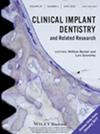A Clinical and Radiographic 3 Years Retrospective Study for Two Types of Locator Retained Mandibular Implant Overdenture
Abstract
Introduction
This retrospective study aimed to evaluate peri-implant marginal bone loss (MBL) and prosthetic complications between two types of locator attachments in two implant-supported mandibular overdentures.
Material and Method
From the archived records, information about patients who had two implants inserted utilizing two different types of locator attachments into the interforaminal region between November 2019 and December 2023 was obtained. Overall, 60 patients (Total = 120 implants) from the archive records of the Prosthodontics Department, Faculty of Dentistry, Mansoura University, with ages ranging from 40 to 60 (mean age 50), were included in the study. Group I (control): Overall, 30 patients who would be delivered mandibular implant overdenture using conventional locator attachments. Group II (study): Overall, 30 patients who would be delivered mandibular implant overdenture using RTx locator attachments. After the placement of the mandibular overdenture (T0), 6 months (T6), 12 months (T12), and 3 years (T3) later, the marginal bone loss (MBL) was assessed. Prosthetic complications were evaluated for both groups 3 years after prosthetic delivery.
Result
A statistically significant increase (p = 0.000) was found in MBL scores at all observation times between both groups. Group II showed a statistical increase in MBL than Group I. For prosthetic complications, no significant difference was found between both groups. Group II showed more matrix wear than Group I however, it was not statistically significant (p = 0.60).
Conclusion
Within the limitation of this study, we can conclude the following: Both types of locator attachment (conventional and RTx locator) can be used clinically with no preference concerning the frequency of prosthetic complications. From the MBL perspective, conventional locators are more favorable than RTx locators.

 求助内容:
求助内容: 应助结果提醒方式:
应助结果提醒方式:


